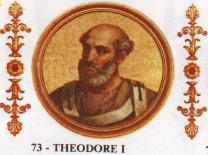
A Greek born in Jerusalem, Theodore I may have come to Rome to escape the Arab invasions of the Holy Land. The son of a bishop, he was elected to the papacy in 642. He opposed monothelitism and received the repentance of Patriarch Pyrrhus of Constantinople, whom St. Maximos the Confessor had humiliated in public debate. (Not restored to the patriarchate, Pyrrhus returned to his heretical views). Theodore called a council at the Lateran before his death in 649 to condemn the Ecthesis of Emperor Heraclius, an expression of monothelitism, and the Typos of Emperor Constans II, which forbade the discussion of will and operation in Christ.
Pope Theodore I (Latin: Theodorus I; died 14 May 649) was the bishop of Rome from 24 November 642 to his death. His pontificate was dominated by the struggle with Monothelitism.
Early career
According to the Liber Pontificalis, Theodore was a Greek man from Jerusalem whose father, Theodore, had been a bishop in the city. He was among the many Syrian clergy who fled to Rome following the Muslim conquest of the Levant. He was made a cardinal deacon possibly around 640 and a full cardinal by Pope John IV.
Pontificate
Theodore I's election was supported by the exarch of Ravenna, who governed Italy in the name of the emperor in Constantinople. He was installed on 24 November 642, succeeding John IV. The main focus of his pontificate was the continued struggle against the heretical Monothelites. He refused to recognize Paul II as the patriarch of Constantinople because Paul's predecessor, Pyrrhus I, had not been correctly replaced. He pressed Emperor Constans II to withdraw the Ecthesis of Heraclius. While his efforts made little impression on Constantinople, it increased the opposition to the teaching in the West; Pyrrhus even briefly recanted Monothelitism in 645, but was excommunicated in 648. Paul was excommunicated in 649. In response, Paul destroyed the Roman altar in the palace of Placidia and exiled or imprisoned the papal apocrisiarius. He also sought to end the issue with the emperor by promulgating the Type of Constans, ordering that the Ecthesis be taken down and seeking to end discussion on the doctrine.
Theodore planned the Lateran Council of 649 to condemn the Ecthesis, but died before he could convene it. His successor, Martin I, did so instead. Theodore was buried in St. Peter's Basilica. His feast day in the Orthodox Church is on 18 May.
Notes
- ^ The Editors of Encyclopædia Britannica. "Theodore I". Encyclopædia Britannica. Retrieved 31 August 2016.
- ^ Anastasius (bibliothecarius) (1602). Bibliothecarii Historia, de vitis romanorvm pontificvm. in typographeio I. Albini. p. 67.
Theodorus, natione Grecus, ex patre Theodoro episcopo de civitate Hierusolima
- ^ Paul F. Bradshaw (2013). New SCM Dictionary of Liturgy and Worship. Hymns Ancient and Modern Ltd. p. 5. ISBN 9780334049326.
- ^ Chisholm 1911.
- ^ Mann 1913.
- ^ (in Greek) Ὁ Ἅγιος Θεόδωρος ὁ Ἱερομάρτυρας Ἐπίσκοπος Ρώμης. 18 Μαΐου. ΜΕΓΑΣ ΣΥΝΑΞΑΡΙΣΤΗΣ.





